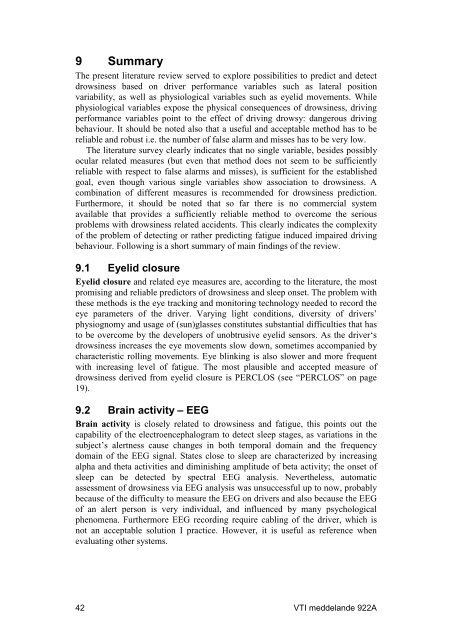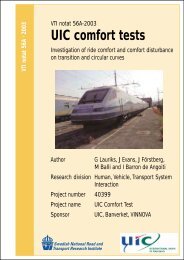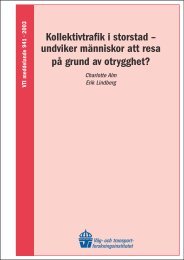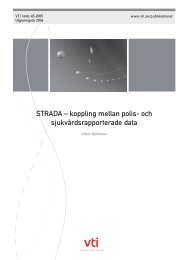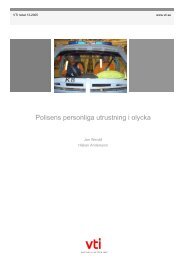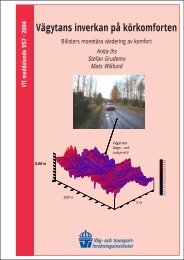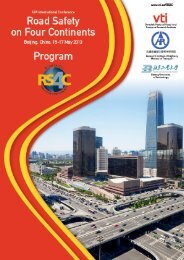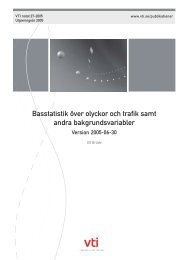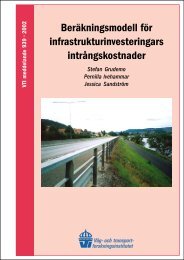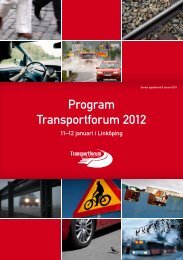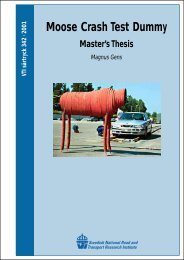Vehicle control and drowsiness - VTI
Vehicle control and drowsiness - VTI
Vehicle control and drowsiness - VTI
- No tags were found...
Create successful ePaper yourself
Turn your PDF publications into a flip-book with our unique Google optimized e-Paper software.
9 SummaryThe present literature review served to explore possibilities to predict <strong>and</strong> detect<strong>drowsiness</strong> based on driver performance variables such as lateral positionvariability, as well as physiological variables such as eyelid movements. Whilephysiological variables expose the physical consequences of <strong>drowsiness</strong>, drivingperformance variables point to the effect of driving drowsy: dangerous drivingbehaviour. It should be noted also that a useful <strong>and</strong> acceptable method has to bereliable <strong>and</strong> robust i.e. the number of false alarm <strong>and</strong> misses has to be very low.The literature survey clearly indicates that no single variable, besides possiblyocular related measures (but even that method does not seem to be sufficientlyreliable with respect to false alarms <strong>and</strong> misses), is sufficient for the establishedgoal, even though various single variables show association to <strong>drowsiness</strong>. Acombination of different measures is recommended for <strong>drowsiness</strong> prediction.Furthermore, it should be noted that so far there is no commercial systemavailable that provides a sufficiently reliable method to overcome the seriousproblems with <strong>drowsiness</strong> related accidents. This clearly indicates the complexityof the problem of detecting or rather predicting fatigue induced impaired drivingbehaviour. Following is a short summary of main findings of the review.9.1 Eyelid closureEyelid closure <strong>and</strong> related eye measures are, according to the literature, the mostpromising <strong>and</strong> reliable predictors of <strong>drowsiness</strong> <strong>and</strong> sleep onset. The problem withthese methods is the eye tracking <strong>and</strong> monitoring technology needed to record theeye parameters of the driver. Varying light conditions, diversity of drivers’physiognomy <strong>and</strong> usage of (sun)glasses constitutes substantial difficulties that hasto be overcome by the developers of unobtrusive eyelid sensors. As the driver‘s<strong>drowsiness</strong> increases the eye movements slow down, sometimes accompanied bycharacteristic rolling movements. Eye blinking is also slower <strong>and</strong> more frequentwith increasing level of fatigue. The most plausible <strong>and</strong> accepted measure of<strong>drowsiness</strong> derived from eyelid closure is PERCLOS (see “PERCLOS” on page19).9.2 Brain activity – EEGBrain activity is closely related to <strong>drowsiness</strong> <strong>and</strong> fatigue, this points out thecapability of the electroencephalogram to detect sleep stages, as variations in thesubject’s alertness cause changes in both temporal domain <strong>and</strong> the frequencydomain of the EEG signal. States close to sleep are characterized by increasingalpha <strong>and</strong> theta activities <strong>and</strong> diminishing amplitude of beta activity; the onset ofsleep can be detected by spectral EEG analysis. Nevertheless, automaticassessment of <strong>drowsiness</strong> via EEG analysis was unsuccessful up to now, probablybecause of the difficulty to measure the EEG on drivers <strong>and</strong> also because the EEGof an alert person is very individual, <strong>and</strong> influenced by many psychologicalphenomena. Furthermore EEG recording require cabling of the driver, which isnot an acceptable solution I practice. However, it is useful as reference whenevaluating other systems.42 <strong>VTI</strong> meddel<strong>and</strong>e 922A


